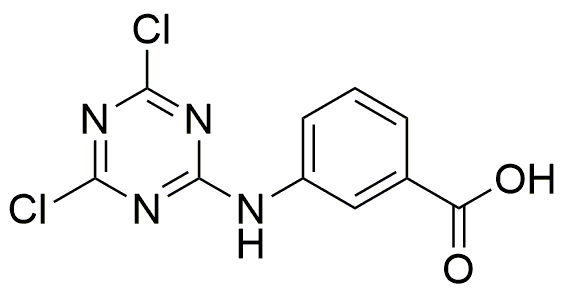2-(3-Carboxyanilino)-4,6-dichloro-1,3,5-triazine is widely utilized in research focused on:
- Agricultural Chemistry: This compound serves as an effective herbicide, helping to control unwanted plant growth in crops. Its targeted action minimizes damage to desirable plants, making it a valuable tool for farmers.
- Pharmaceutical Development: It is used in the synthesis of various pharmaceutical agents, providing a framework for developing new drugs. Researchers appreciate its versatility in modifying biological activity.
- Analytical Chemistry: The compound is employed as a reagent in analytical methods, aiding in the detection and quantification of specific substances in complex mixtures, which is crucial for quality control in manufacturing.
- Material Science: It finds applications in the development of advanced materials, such as coatings and polymers, enhancing their properties like durability and resistance to environmental factors.
- Environmental Science: This chemical is utilized in studies assessing the impact of pollutants, helping researchers understand chemical interactions in ecosystems and contributing to environmental protection efforts.
General Information
Properties
Safety and Regulations
Applications
2-(3-Carboxyanilino)-4,6-dichloro-1,3,5-triazine is widely utilized in research focused on:
- Agricultural Chemistry: This compound serves as an effective herbicide, helping to control unwanted plant growth in crops. Its targeted action minimizes damage to desirable plants, making it a valuable tool for farmers.
- Pharmaceutical Development: It is used in the synthesis of various pharmaceutical agents, providing a framework for developing new drugs. Researchers appreciate its versatility in modifying biological activity.
- Analytical Chemistry: The compound is employed as a reagent in analytical methods, aiding in the detection and quantification of specific substances in complex mixtures, which is crucial for quality control in manufacturing.
- Material Science: It finds applications in the development of advanced materials, such as coatings and polymers, enhancing their properties like durability and resistance to environmental factors.
- Environmental Science: This chemical is utilized in studies assessing the impact of pollutants, helping researchers understand chemical interactions in ecosystems and contributing to environmental protection efforts.
Documents
Safety Data Sheets (SDS)
The SDS provides comprehensive safety information on handling, storage, and disposal of the product.
Product Specification (PS)
The PS provides a comprehensive breakdown of the product’s properties, including chemical composition, physical state, purity, and storage requirements. It also details acceptable quality ranges and the product's intended applications.
Certificates of Analysis (COA)
Search for Certificates of Analysis (COA) by entering the products Lot Number. Lot and Batch Numbers can be found on a product’s label following the words ‘Lot’ or ‘Batch’.
*Catalog Number
*Lot Number
Certificates Of Origin (COO)
This COO confirms the country where the product was manufactured, and also details the materials and components used in it and whether it is derived from natural, synthetic, or other specific sources. This certificate may be required for customs, trade, and regulatory compliance.
*Catalog Number
*Lot Number
Safety Data Sheets (SDS)
The SDS provides comprehensive safety information on handling, storage, and disposal of the product.
DownloadProduct Specification (PS)
The PS provides a comprehensive breakdown of the product’s properties, including chemical composition, physical state, purity, and storage requirements. It also details acceptable quality ranges and the product's intended applications.
DownloadCertificates of Analysis (COA)
Search for Certificates of Analysis (COA) by entering the products Lot Number. Lot and Batch Numbers can be found on a product’s label following the words ‘Lot’ or ‘Batch’.
*Catalog Number
*Lot Number
Certificates Of Origin (COO)
This COO confirms the country where the product was manufactured, and also details the materials and components used in it and whether it is derived from natural, synthetic, or other specific sources. This certificate may be required for customs, trade, and regulatory compliance.


